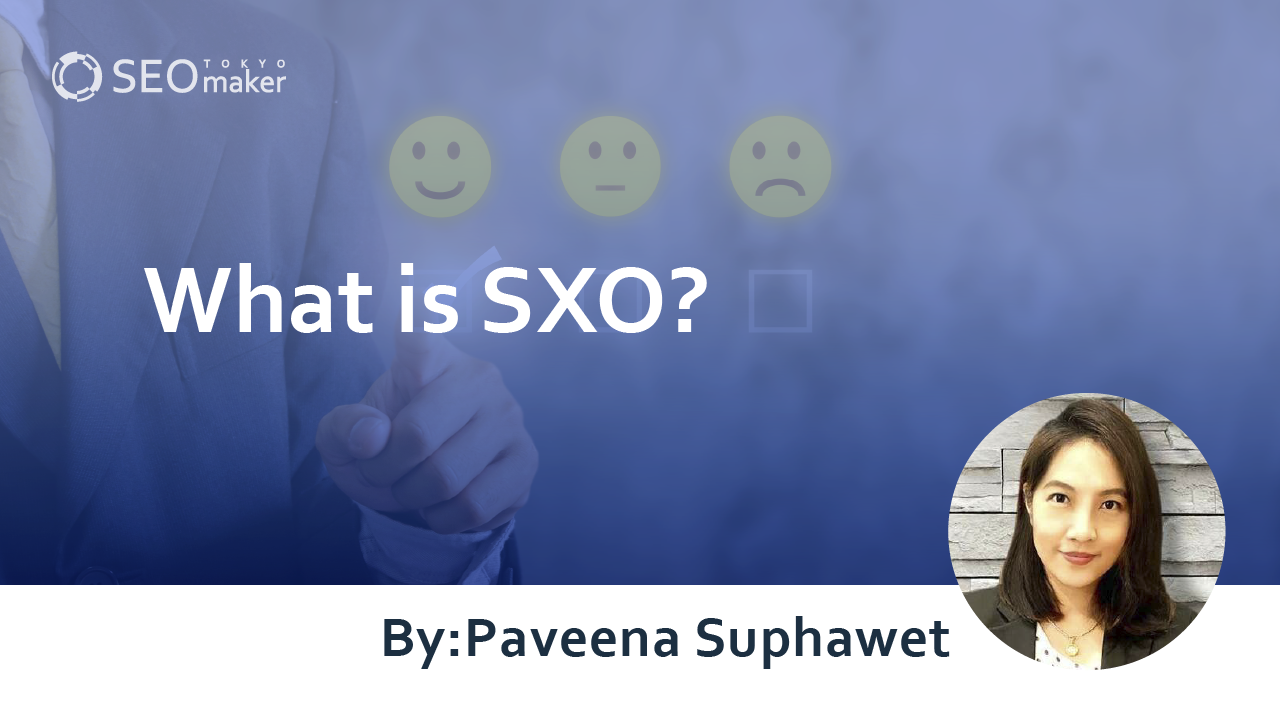What is SXO? Explaining the Differences from SEO and Detailed Strategies and Considerations
contents
- 1 What is SXO?
- 2 Five SXO Strategies
- 3 Considering Both Users and Search Engines
- 4 Common Questions About SXO (Q&A)
- 5 Summary

In web marketing, it’s not enough to just rank high in SEO. Beyond getting users to visit your website, it’s crucial to provide an experience that makes them feel their needs have been met.
Therefore, in this discussion, we will delve into SXO, a strategy aimed at enhancing user satisfaction in search.
- What is SXO?
- Differences Between SEO and SXO
- SEO vs. SXO
What is SXO?
SXO, or Search Experience Optimization, focuses on optimizing a website to meet the needs of search users effectively.
Specifically, it involves improving website structure, content, design, and alignment with search keywords to provide users with a better search experience. As a result, this can lead to increased search rankings and traffic.
Differences Between SEO and SXO
While SEO focuses on optimizing websites for better search engine visibility and rankings, SXO encompasses broader strategies aimed at satisfying the needs of search users.
For example, if a user searches for “English conversation Tokyo,” achieving a top ranking for your website in the search results would be an SEO goal. However, ensuring that the user’s needs are met when they visit your website is the essence of SXO.
- SEO: Strategies aimed at achieving higher site rankings using targeted keywords, with the goal of increasing website traffic.
- SXO: Strategies aimed at releasing information that search users are seeking, with the goal of satisfying users’ search needs and ensuring their satisfaction.
Benefits of Implementing SXO
SXO focuses on enhancing satisfaction and comfort for visitors coming through search engines. Here, we’ll outline the advantages of implementing SXO strategies.
- Improve User Satisfaction . By accurately providing the information users seek, SXO can significantly enhance user satisfaction. Satisfied users are more likely to become repeat visitors to your website, which can lead to more product purchases and an increase in website traffic.
- Increase in Click-Through Rate (CTR). Implementing SXO can improve your click-through rates by matching search results more closely to user needs. A higher click-through rate positively impacts your search engine rankings.
- Differentiation from Competitors . Providing users with the clearest possible information can differentiate us from our competitors. Users prefer websites that help them solve their problems more easily. By implementing Search Experience Optimization (SXO), we can transform our site into a user-first website.
Five SXO Strategies
What specific actions should be taken as part of SXO strategies?
While the specifics vary, prioritize user-centric approaches based on Google’s “10 Things Google Knows to be True” when implementing any strategy.
Please focus on meeting user convenience and needs rather than company convenience. Here are five specific SXO strategies
Reference: Google’s “10 Things Google Knows to be True”
1. Easy-to-Understand Content
The first SXO strategy focuses on content. Use clear and easy-to-understand text, images, and videos to accurately meet the information needs of search users. It’s essential not only that the content is accurate but also that it’s organized and presented in a way that’s easy to understand.
When creating content, also consider the following
- Readable Fonts . Choose fonts that are easy to read for body text, titles, and headings. The choice may vary based on industry and company branding, but it’s important to select something appropriate that matches how you want users to perceive your company while ensuring good readability.
- Concise and clear writing . Avoid lengthy and indirect expressions. It’s crucial that your message is immediately clear to users. Review and edit your text to make it as concise and understandable as possible.
- Visual Appeal . Organize your content with appropriate use of visuals like images and icons. When visuals such as images, graphs, or tables are more effective in conveying your message, prefer these methods of expression.
This approach to content and site optimization keeps the user’s needs at the forefront, ensuring your website stands out in a crowded market.
2. Improving Website Security
Ensuring users can safely access your website is a key part of Search Experience Optimization (SXO). A specific measure includes switching from HTTP to HTTPS. Additionally, web managers should progressively implement the following measures as possible
- Strengthening Passwords . Normally, accessing the admin page of a website requires a password. Weak passwords can lead to website hijacking. Change passwords regularly and choose ones that are hard to guess.
- Update Your CMS. If you’re using a CMS like WordPress to build your website, make sure to keep the system and plugins up to date. The latest versions address known vulnerabilities.
- Install Firewalls. Protect your website from unauthorized access and attacks by installing a firewall on your web server.
- Regular Backups. Websites can be attacked and data can be corrupted. Therefore, conduct regular full backups (of all data) and differential backups (only changes). If attacked, having backups allows for data restoration.
3. Mobile Friendly
Most users browse websites on mobile devices, primarily smartphones, making mobile-responsive websites desirable.
Websites not optimized for mobile can result in poor visibility and readability. Since the introduction of the mobile-first index in March 2018, search ranking has increasingly focused on mobile site elements.
To make your page mobile-friendly, consider the following
- Optimize for Touch Mobile devices primarily use touch. Make buttons and links easy to press with fingers. Consider not only the colors but also the size of buttons.
- Simplify Content Mobile screens are smaller, and excessive content can drive users away. As part of SXO, it’s crucial to trim unnecessary content to the essentials.
- Test on Mobile Devices Web managers should personally test their websites on mobile devices. Issues not visible on PCs can often be discovered when accessing the site via a mobile device.
4. Lightening the Page Load
To ensure visitors to your website can view pages without stress, it’s crucial to lighten the site. By reducing the file sizes used on your website, you can improve page load speeds. Specifically, consider the following measures
- Reduce Image Sizes
- Compress images without sacrificing their size
- Compress External Files (CSS and JavaScript)
5. Enhancing EEAT
Content that elevates Experience, Expertise, Authoritativeness, and Trustworthiness (EEAT) is more likely to meet user needs and result in a satisfying website experience. To create content that enhances EEAT, focus on providing information in areas where your company excels, rather than covering a wide range of topics.
Other ways to enhance EEAT include
- Expert Content
Provide information that showcases your company’s expertise. Content should be accurate and include unique perspectives only experts can offer. In some cases, it might be necessary to share unique data or research findings.
- Links to Trustworthy Sources
Linking to information sources already recognized as experts or authoritative organizations can enhance the credibility of your own website.
- Receiving Reviews and Ratings
Allowing users to review your website and publishing those reviews can enhance the credibility of your website. Often, the raw voices of users are seen as more trustworthy than corporate messages.
Misguided SXO Strategies
Here, we’ll discuss what not to do in your SXO efforts. Avoid the following actions, as they disregard the user experience
- Keyword Stuffing
Do not overload specific pages of your website with too many keywords. This practice, known as keyword stuffing, ignores the needs of the user and can significantly harm the user experience, negatively affecting SXO.
- Unnatural Link Placement
Avoid excessively increasing the number of links in the hope of improving SEO. If it confuses visitors to your website, it’s a negative in terms of SXO. Place links naturally, where users might genuinely want more detailed information.
Excessive Advertising Display
While advertising is necessary for conducting business on a website, displaying too many ads can negatively affect user readability and is seen as a drawback from an SXO perspective. Keep the amount of advertising reasonable.
Content Duplication or Similar Content
Avoid posting content that is identical or too similar to that of other companies. Emphasize the uniqueness that can only be conveyed by your company’s website. Unique content is valuable to users for this reason.
Points to Consider When Working on SXO
Here are some points to keep in mind as you implement SXO strategies. Please proceed with measures adhering to the following items
-
Understand User Intent
Searchers input specific keywords in the search bar with certain needs in mind. As a web manager, thoroughly consider what needs searchers might have in relation to their search keywords.
For example, if the search keyword is “used Toyota cars under 1 million yen,” the likely search intent is “wanting to buy a used Toyota car for under 1 million yen.”
Thus, there are specific needs behind each search keyword. Aim to create content that fulfills these needs as you work on SXO strategies.
Considering Both Users and Search Engines
It’s crucial that your content communicates effectively to both users and search engines. Create content that is valuable for users while also making it clear to search engines what the page is about and what needs it aims to fulfill.
For instance, when addressing users, consider the order in which information should be conveyed. At the same time, use the following tags to accurately communicate the content to search engines
- Heading Tags
- Link Tags
- Alt Attributes
- List Tags
There are six types of heading tags, from H1 to H6, with H1 being the highest level heading and the rest descending in importance.
Link tags are used to convey URLs to other pages within the page.
The alt attribute serves to provide text in place of images when they cannot be displayed, briefly describing the content of the image.
List tags, such as “ol” and “ul” are used to present information in a list format.
Using these tags appropriately ensures that search engines correctly understand your content.
Supporting Multiple Languages .
Your company’s website isn’t only accessed by people in Japan. Depending on your industry, you might also receive traffic from overseas. Therefore, make sure your website supports multiple languages, such as English or Chinese.
To make your website multilingual, here are some approaches you can take.
- Install Plugins
If your website is built on WordPress, you can easily make it multilingual by using a plugin designed for this purpose.
Using Translation Services.
Using translation services can easily make your website multilingual. However, be cautious of the quality since translation errors can occur with any tool.
Hiring Native Speakers.
Hiring native speakers for translations is the most reliable method. Although it costs more, the return on investment can be significant, especially if you receive a lot of international traffic.
Optimizing Title Tags and Meta Descriptions
Titles and meta descriptions appear in search results, so clearly state what needs your page can fulfill and use attractive expressions to describe it.
Increasing Update Frequency.
It’s very important for users to access the latest information. Sharing outdated information can disadvantage users. Therefore, frequently update your content to keep the information fresh.
Listening to User Feedback.
Make it possible to receive feedback from visitors by providing survey or contact forms. Listening to user feedback helps identify areas for improvement, leading to a website that offers a fantastic user experience.
Common Questions About SXO (Q&A)
Here, we answer some common questions about SXO.
Q: What skills are needed to practice SXO?
A: To practice SXO, you need skills in web design and writing, as well as knowledge about usability. It’s also desirable to have knowledge about SEO to ensure search engines properly understand your website.
Q: What benefits can be gained from practicing SXO?
A: By providing useful information to users, their satisfaction increases. As a result, this can lead to higher conversion rates and aid in brand building. More repeat visitors to your website also have a positive impact on SEO.
Q: Are there any tools that can help with practicing SXO?
A: Google Analytics and Search Console are helpful for SXO. They allow you to grasp search keyword trends and check user behavior on your website.
Summary
I’ve shared the basics of SXO, specific measures, and points to watch. Many web managers tend to focus only on SEO measures for higher rankings. However, that alone won’t satisfy users. If you desire long-term success for your website, consider the advice in this article and also work on SXO measures.










![What is a Description? Explaining the Meaning, Writing Style, and Changing Word Count – [2023 Edition]](https://www.switchitmaker2.com/en/wp-content/uploads/2024/09/what-is-description.webp)










